| Article ID | Journal | Published Year | Pages | File Type |
|---|---|---|---|---|
| 4410858 | Chemosphere | 2011 | 7 Pages |
Bisphenol A is an endocrine disrupting compound, which is ubiquitous in the environment due to its wide use in plastic and resin production. Seven day old cultures of the litter-decomposing fungus Stropharia coronilla removed the estrogenic activity of bisphenol A (BPA) rapidly and enduringly. Treatment of BPA with purified neutral manganese peroxidase (MnP) from this fungus also resulted in 100% reduction of estrogenic activity, as analyzed using a bioluminescent yeast assay, and in the formation of polymeric compounds. In cultures of Stropharia rugosoannulata, estrogenic activity also quickly disappeared but temporarily re-emerged in the further course of cultivation. LC–MS analysis of the extracted estrogenic culture liquid revealed [M−H]− ions with m/z values of 219 and 235. We hypothesize that these compounds are ring fission products of BPA, which still exhibit one intact hydroxyphenyl group to interact with estrogen receptors displayed by the yeast.
Research highlights► Litter-decomposing fungi and their extracellular enzymes convert bisphenol A. ► Estrogenic activity of bisphenol A is removed rapidly and enduringly. ► Metabolites of bisphenol A exhibit only marginal or no estrogenic activity at all. ► Metabolites include polymerization and decomposition products of bisphenol A. ► Hypothetical pathways of bisphenol A conversion are described.
